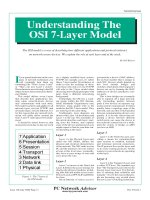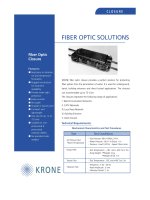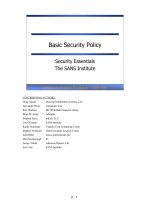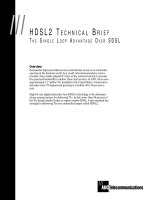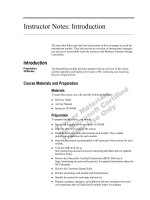Tài liệu Operating System Basics doc
Bạn đang xem bản rút gọn của tài liệu. Xem và tải ngay bản đầy đủ của tài liệu tại đây (1014.98 KB, 33 trang )
le s s o n 11
Operating System
Basics
•
Resource Manager
- Resource include: CPU, memory, disk, network
- OS allocates and de-allocates these resources
•
Virtual Machine
- provides an abstraction of a larger (or just different
machine)
- Example:
- Virtual memory: looks like more memory
- Java: pseudo machine that looks like a stack
machine
- IBM VM: a complete virtual machine
•
Multiplexor
- allows sharing of resources and protection
What is an Operating System
•
Provider of Services
- includes most of the things in the above definitions
- provide “common” subroutes for the programmer
- windowing systems
- memory management
•
The software that is always loaded/running
- generally refers to the OS kernel
- small protected piece of software
•
All of these definitions are correct
- but not all operating have all of these features
What is OS (cont.)
•
Robustness
- accept all valid input
- detect and gracefully handle all invalid input
- should not be possible to crash the OS
•
Consistency
- same operation should mean the same thing
* read from a file or a network should look the
same
* a “-” flag should be the same in different
commands
- conventions
* define the convention
* follow the convention when adding new items
Usability Goals
•
Proportionality
- simple, common cases are easy and fast
* good default values
- complex, rare cases are possible but more complex and
slower
* “rm” should give a warning
* formatting the disk should not be on the
desktop next to the trash can
Usability Goals (cont.)
This lesson includes the following sections:
•
The User Interface
•
Running Programs
•
Managing Files
•
Managing Hardware
•
Utility Software
•
Graphical User Interfaces (GUIs)
•
GUI Tools
•
Applications and the Interface
•
Menus
•
Dialog Boxes
•
Command-Line Interfaces
The User Interface
•
Graphical User Interfaces (GUIs)
•
GUI Tools
•
Applications and the Interface
•
Menus
•
Dialog Boxes
•
Command-Line Interfaces
The User Interface
•
Most modern operating systems, like Windows and
the Macintosh OS, provide a graphical user interface
(GUI).
•
A GUI lets you control the system by using a mouse
to click graphical objects on screen.
•
A GUI is based on the desktop metaphor. Graphical
objects appear on a background (the desktop),
representing resources you can use.
The User Interface
- Graphical User Interfaces (GUIs)
Icons
Start menu
Start button
Taskbar
Desktop
Dialog box
Program
running in
a window
Window control buttons
•
Icons are pictures that represent computer
resources, such as printers, documents, and
programs.
•
You double-click an icon to choose (activate) it, for
instance, to launch a program.
•
The Windows operating system offers two unique
tools, called the taskbar and Start button. These
help you run and manage programs.
The User Interface - GUI Tools
Or, icons can be
double-clicked to
launch programs.
The Windows start
button can be used
to launch programs.
•
Applications designed to run under one operating
system use similar interface elements.
•
Under an OS such as Windows, you see a familiar
interface no matter what programs you use.
•
In a GUI, each program opens and runs in a separate
window—a frame that presents the program and its
documents.
•
In a GUI, you can run multiple programs at once,
each in a separate window. The application in use is
said to be the active window.
The User Interface –
Applications and the Interface
Titlebar
Menubar
Toolbar
Scroll arrow
Scroll box
Scroll bar
Click the Minimize button to reduce
the program to a button on the taskbar.
Click the Maximize button to restore
the window to its previous size.
Click the Close button to close
the window altogether.
•
GUI-based programs let you issue commands by
choosing them from menus.
•
A menu groups related commands. For example, the
File menu's commands let you open, save, and print
document files.
•
Menus let you avoid memorizing and typing
command names.
•
In programs designed for the same GUI, menus and
commands are similar from one program to another.
The User Interface - Menus
•
A dialog box is a special window that appears when
a program or the OS needs more information
before completing a task.
•
Dialog boxes are so named because they conduct a
"dialog" with the user, asking the user to provide
more information or make choices.
The User Interface - Dialog Boxes
•
Some older operating systems, such as DOS (Disk
Operating System) and UNIX, use command-line
interfaces.
•
In a command-line interface, you type commands at a
prompt.
•
Under command-line interfaces, individual
applications do not need to look or function the same
way, so different programs can look very different
.
The User Interface - Command-Line Interfaces
The DOS Prompt is not seen much these days!
•
Basic Services
•
Sharing Information
•
Multitasking
Running Programs
•
The operating system manages all the other
programs that run on the PC.
•
The operating system provides services to programs
and the user, including file management, memory
management, and printing
•
To provide services to programs, the OS makes
system calls—requesting other hardware and
software resources to perform tasks.
Running Programs - Basic Services
•
Some operating systems, such as Windows, enable
programs to share information.
•
You can create data in one program and use it again
in other programs without re-creating it.
•
Windows provides the Clipboard, a special area that
stores data cut or copied from one document, so
you can re-use it elsewhere.
Running Programs - Sharing Information
1
2
3
Information is clipped
from one application (Excel)
Using the clipboard Viewer to
examine the information
Pasting the information
into another application (WordPro)
•
Multitasking is the capability of running multiple
processes simultaneously.
•
A multitasking OS lets you run multiple programs at
the same time.
•
Through multitasking, you can do several chores at
one time, such as printing a document while
downloading a file from the Internet.
•
There are two types of multitasking: cooperative and
preemptive.
Running Programs - Multitasking
